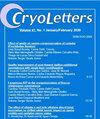Liquid nitrogen improves the decellularization effectiveness of whole-ovary.
IF 1
4区 生物学
Q3 BIOLOGY
引用次数: 0
Abstract
BACKGROUND Ovarian tissue cryopreservation for fertility preservation carries a risk of malignant cell re-seeding. Artificial ovary is a promising method to solve such a problem. However, ovary decellularization protocols are limited. Hence, further studies are necessary to get better ovarian decellularization techniques for the construction of artificial ovary scaffolds. OBJECTIVE To establish an innovative decellularization technique for whole porcine ovaries by integrating liquid nitrogen with chemical agents to reduce the contact time between the scaffolds and chemical reagents. MATERIALS AND METHODS Porcine ovaries were randomly assigned to three groups: novel decellularized group, conventional decellularized group and fresh group. The ovaries in the novel decellularized group underwent three cycles of freezing by liquid nitrogen and thawing at temperatures around 37 degree C before decellularization. The efficiency of the decellularization procedure was assessed through histological staining and DNA content analysis. The maintenance of ovarian decellularized extracellular matrix(ODECM) constituents was determined by analyzing the content of matrix proteins. Additionally, we evaluated the biocompatibility of the decellularized extracellular matrix(dECM) by observing the growth of granulosa cells on the ODECM scaffold in vitro. RESULTS Hematoxylin and eosin staining, DAPI staining and DNA quantification techniques collectively confirm the success of the novel decellularization methods in removing cellular and nuclear components from ovarian tissue. Moreover, quantitative assessments of ODECM contents revealed that the novel decellularization technique preserved more collagen and glycosaminoglycan compared to the conventional decellularized group (P<0.05). Additionally, the novel decellularized scaffold exhibited a significantly higher number of granulosa cells than the conventional scaffold during in vitro co-culture (P<0.05). CONCLUSION The novel decellularized method demonstrated high efficacy in eliminating DNA and cellular structures while effectively preserving the extracellular matrix. As a result, the novel decellularized method holds significant promise as a viable technique for ovarian decellularization in forthcoming studies. Doi.org/10.54680/fr24310110212.液氮提高了全卵巢脱细胞的效果。
背景卵巢组织冷冻保存用于生育力保存具有恶性细胞再播种的风险。人工卵巢是解决这一问题的可行方法。然而,卵巢脱细胞方案有限。材料与方法将猪卵巢随机分为三组:新型脱细胞组、传统脱细胞组和新鲜组。新型脱细胞组的卵巢在脱细胞前经过三次液氮冷冻,并在 37 摄氏度左右的温度下解冻。脱细胞过程的效率通过组织学染色和DNA含量分析进行评估。通过分析基质蛋白的含量,确定了卵巢脱细胞细胞外基质(ODECM)成分的维持情况。此外,我们还通过体外观察颗粒细胞在脱细胞细胞外基质支架上的生长情况,评估了脱细胞细胞外基质(dECM)的生物相容性。结果血红素和伊红染色、DAPI染色和DNA定量技术共同证实了新型脱细胞方法能成功去除卵巢组织中的细胞和核成分。此外,对 ODECM 含量的定量评估显示,与传统脱细胞组相比,新型脱细胞技术保留了更多的胶原蛋白和糖胺聚糖(P<0.05)。此外,在体外共培养过程中,新型脱细胞支架显示的颗粒细胞数量明显高于传统支架(P<0.05)。因此,在未来的研究中,新型脱细胞方法有望成为一种可行的卵巢脱细胞技术。Doi.org/10.54680/fr24310110212.
本文章由计算机程序翻译,如有差异,请以英文原文为准。
求助全文
约1分钟内获得全文
求助全文
来源期刊

Cryo letters
生物-生理学
CiteScore
1.80
自引率
10.00%
发文量
50
审稿时长
1 months
期刊介绍:
A bimonthly international journal for low temperature sciences, including cryobiology, cryopreservation or vitrification of cells and tissues, chemical and physical aspects of freezing and drying, and studies involving ecology of cold environments, and cold adaptation
The journal publishes original research reports, authoritative reviews, technical developments and commissioned book reviews of studies of the effects produced by low temperatures on a wide variety of scientific and technical processes, or those involving low temperature techniques in the investigation of physical, chemical, biological and ecological problems.
 求助内容:
求助内容: 应助结果提醒方式:
应助结果提醒方式:


